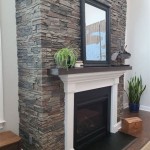Gas Fireplace Pipe Size: Understanding the Essentials for Safety and Efficiency
A gas fireplace can be a beautiful addition to any home, providing warmth and ambiance during the colder months. However, the proper installation of these appliances is crucial for safety and efficiency. One critical aspect of installation is the size of the vent pipe that connects the fireplace to the outside. Understanding the factors that influence vent pipe size is essential to ensure the system operates correctly and meets safety standards.
Factors Determining Gas Fireplace Pipe Size
Several factors influence the appropriate size of the vent pipe for a gas fireplace, each impacting the system's ventilation and performance. These factors include:
1. Fireplace BTU Output
BTU (British thermal unit) output measures the amount of heat a gas fireplace produces. Higher-BTU fireplaces require larger vent pipes to accommodate the greater volume of exhaust gases. The manufacturer's specifications for the fireplace will indicate the recommended vent pipe size based on the BTU rating.
2. Vent Pipe Material
Vent pipe materials have different properties affecting their ability to carry exhaust gases. Common materials include stainless steel, aluminum, and PVC. Stainless steel is the preferred material for gas fireplaces due to its durability, heat resistance, and corrosion resistance. The material choice can also influence the appropriate pipe size as different materials have varying flow rates.
3. Vent Pipe Length and Configuration
The length and configuration of the vent pipe also play a significant role in determining the appropriate size. Longer vent pipes with multiple bends will experience increased friction and require a larger diameter to maintain proper airflow. Similarly, horizontal sections of the vent pipe require larger sizes compared to vertical segments.
4. Local Building Codes
Local building codes and regulations often specify minimum requirements for vent pipe sizes and materials. It is crucial to consult these codes before installing a gas fireplace to ensure compliance and safety.
Importance of Proper Vent Pipe Sizing
Installing the correct size vent pipe for a gas fireplace offers several advantages, including:
1. Safety
An undersized vent pipe can restrict the flow of exhaust gases, resulting in a buildup of harmful carbon monoxide within the home. This poses a serious health risk and could even lead to a fire. Conversely, an oversized vent pipe may lead to excessive heat loss, reducing the fireplace's efficiency.
2. Efficiency
Correct vent pipe sizing ensures optimal combustion and heat output. An undersized pipe can restrict airflow, leading to incomplete combustion and reduced heat production. Conversely, an oversized vent pipe can lead to excessive heat loss, making the fireplace less efficient and increasing energy costs.
3. Longevity
The proper vent pipe size contributes to the longevity of the gas fireplace. An undersized vent pipe can cause excess heat and stress on the system's components, leading to premature wear and tear. Conversely, an oversized pipe might not effectively remove condensation, potentially causing corrosion within the system.
Choosing the Right Vent Pipe Size
Determining the appropriate vent pipe size for your gas fireplace requires careful consideration of all the factors mentioned above. To simplify this process, consider these steps:
1. Consult the Fireplace Manufacturer's Specifications
The most reliable source of information regarding the vent pipe size is the fireplace manufacturer's specifications. These specifications will outline the required pipe size based on the fireplace's BTU output, vent pipe material, and any other relevant factors.
2. Contact a Certified Gas Appliance Installer
A certified gas appliance installer has the expertise to assess your specific situation and recommend the appropriate vent pipe size for your gas fireplace. They can consider factors like the fireplace's location, the venting configuration, and local building codes to ensure a safe and efficient installation.
3. Consider the Future
When choosing the vent pipe size, consider potential future modifications or additions to your home. If you anticipate adding an extension or upgrading the fireplace in the future, choosing a slightly larger pipe size might prevent the need for modifications later on.
Investing time in understanding the factors that influence vent pipe size can ensure a safe and efficient gas fireplace installation. Consulting the manufacturer's specifications, contacting a certified gas appliance installer, and considering future modifications will lead to an informed decision that promotes safety, efficiency, and the longevity of your gas fireplace.

Liner Sizing Help Chimney Depot

Determining Fireplace Liner Sizing

Chimney Liners Usa Size A Fireplace Liner

How To Size Gas Pipework In 4 Simple Steps H2x Engineering

Liner Sizing Help Chimney Depot

Liner Sizing Help Chimney Depot

Determining Fireplace Liner Sizing

Gas Fireplace Flue Exterior Inspections Internachi Forum

Vented Vs B Vent Direct Free Dixie S

Chimney Sizing
Related Posts








